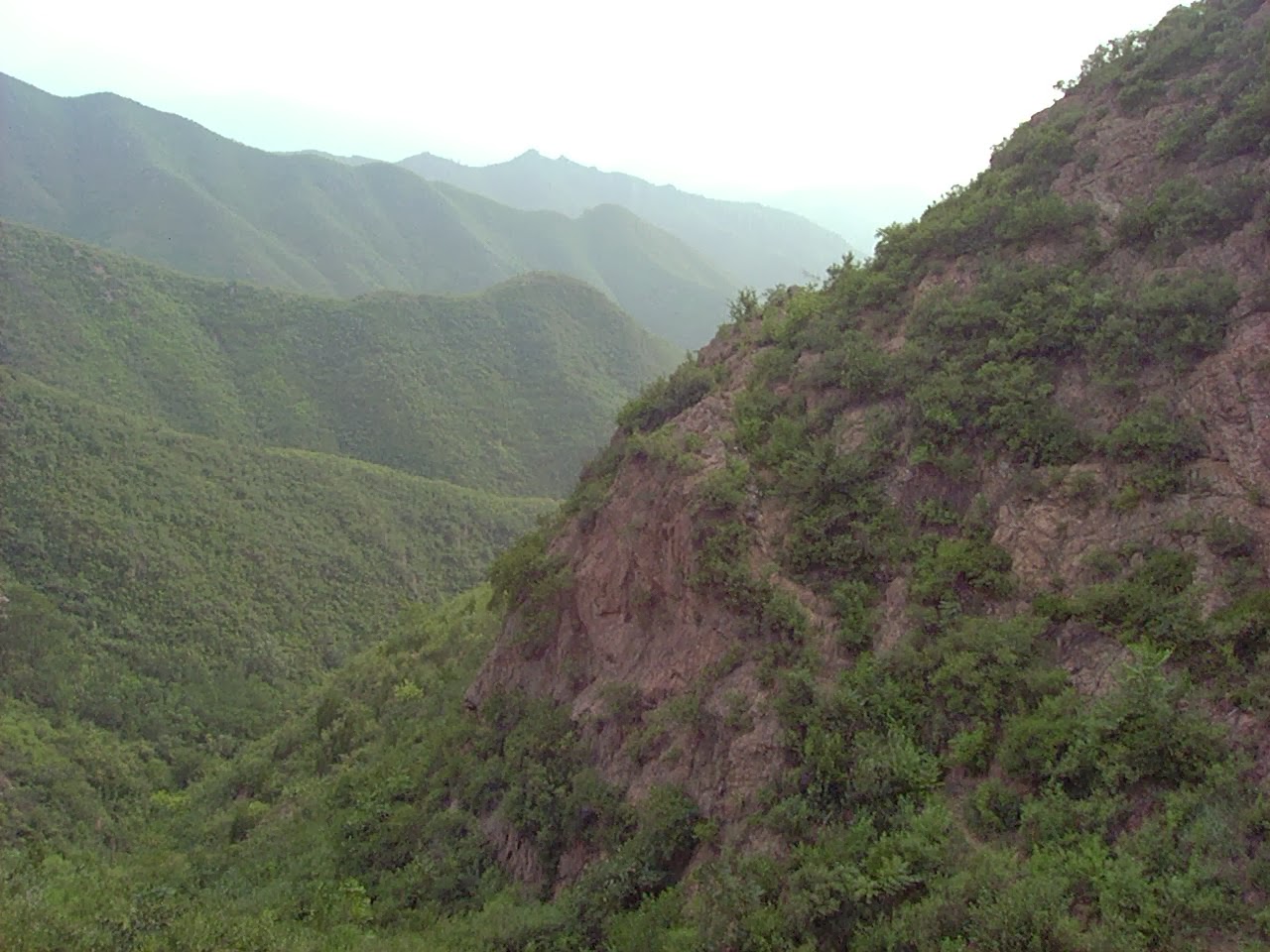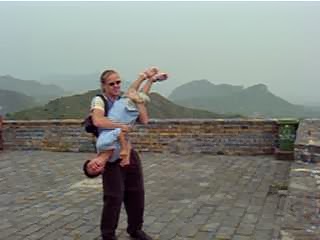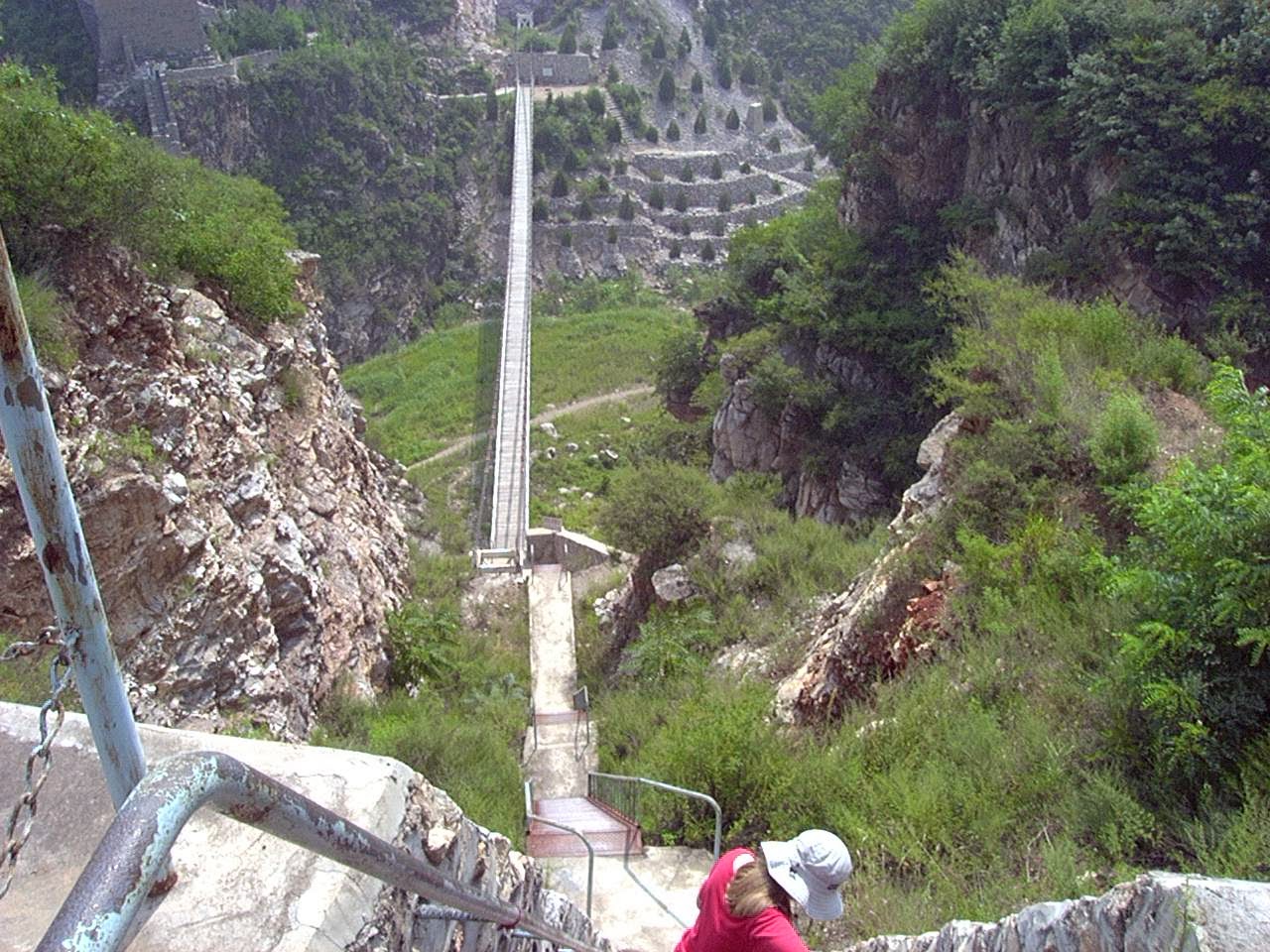While traveling in China I realized that the best and perhaps most literal historical example of a barrier to the diffusion of people and ideas is the Great Wall of China. Yet an exploration of the wall itself can inspire one to see it not as an absorbing barrier completely halting mobility but as a permeable barrier that may even aid the circulation of people and their ideas.
Originally dating to the 7th century B.C. and stretching over 13 thousand miles, this huge structure in many ways defined the early Chinese as a nation and a people by clearly marking it's outer and interior borders and national identity.
The hike to the wall started just after dawn to beat
the crowds and the heat that would build up later in the day. It was August and just about the hottest and most humid month of my life. I had been to tropical and semi-tropical places before but never during their summer. The humidity seemed to mix with their infamous smog to create a particularly tough to breathe soup.
As you can see, the architecture is a very unique and recognizable Chinese folk culture style that's replicated through much of the local cultural landscape. Our location here is technically on the border zone of ancient China and what is now more of a vernacular region “Inner Mongolia” which is now part of China and not a part of the neighboring nation of Mongolia. A "vernacular region" is an area defined by the local culture and that usually has a nickname like "The Iron Belt". The population here is largely an indigenous culture of ethnic Mongolians and not the Han Chinese. There are many minority ethnic groups in China outside of the Han Chinese most people think of when they picture a more monolithic Chinese population in popular culture.
As we began our hike to the wall, a crowd of locals gathered. This was in 2003 when there were still few Western tourists and often a group of exotic foreigners such as ourselves could cause a stir. We didn't know it at the time but these locals routinely will follow tourists in the hopes of selling them some supplies or mementos.
As we got closer to the wall we noticed there was something of an amusement park outside one of the main entrances. I think they had some grand plans for how much tourist money they would make from these leisure landscapes, but nobody was using them when we were there. To be honest, they didn't look particularly fun either. In fact, there is a surprising number of abandoned amusement parks around the world if you have ever done a search on the topic. Many places around the world have tried to expand their tourist industry by adding amenities like this but often people simply don't have the additional money or time to spend on such things, I know we didn't.
It seemed to me as something of a misunderstanding of what tourists might want to spend their time on. Who wants to go on a go cart track or other rides when you are there to see The Great Wall of China? Some food, water, or books on the wall would have been a much better from a sales perspective, but live and learn.
I wasn't the only one to have this thought as you can see the locals carried books and other material they thought we might buy in these bags you see them carrying.

If you might think that this structure is in very good condition for being nearly 3000 years old, you would be right. Much of the wall has been reconstructed time and again after various battles or just normal weathering. Whenever you see The Great Wall of China on TV or in pictures it is rare that you would see any section that is not kept in near perfect condition. This is useful for the local economy because tourists would rather imagine the wall at its height even if it has been relatively recently reconstructed. What kind of crazy person would hike miles and miles out to see what the original wall looks like? Ya, that would be me.
I assume this says something like "LOOK AT OUR AMAZING WALL!" but I honestly don't know. Can any readers interpret it for me?
If you look at the rugged landscape around where the wall is built, you can see how this would already be a tough area to cross on foot. In fact, this perspective allows you another opposite view of this wall not as a barrier but as a very functional road for those who would travel upon it. It isn't often in life that a seemingly insurmountable barrier can be viewed as an aid to the mobility of people and geographic dispersion but that is exactly how this Wall functioned in ancient and not so ancient times. Having control of the wall not only functioned as a barrier but also as a profitable trade route for the nations coffers.
As you can see, some areas are quite steep and go nearly straight up.
As a modern day worldwide tourist destination, this wall is now much more likely to bring people together rather than keep them apart. Our group alone represented several countries.
Our guide Ross from South Africa playing with local children on the wall.
I often wonder what kind of affect all of us tourists have on these places. Economic development like any kind of development is very uneven around the world. These children may now be adults. Are they still selling knickknacks along the wall? Did our tourist money help the locals break out of poverty or are things basically the same?
In my many travels, I have of course often purchased souvenirs of many kinds. Typically sales people can be quite aggressive depending on where you are visiting. In Egypt, a shop owner may offer a handshake but then not let go until you have purchased something.
I will say that these locals primarily walked with us and didn't push anything on us until we asked. For hours we would say no to the water and sandwiches they carried but eventually we were worn down and found these things to be extremely inexpensive anyway. Our group ended up buying a ton of their souvenirs. In a world where many people live on less than a dollar per day, they made a handsome profit for their long and patient walk with us.
Although it was high summer, the combination of humidity and pollution make for a thick fog that often obscures the sun. You can make it out in these pictures although it is quite dim. People describe the smog as being like smoking a pack of cigarettes a day, but I can't confirm that similarity as I have never smoked. I will say that this hike and others we did were more exhausting than I thought they should be and we would all find ourselves out of breath.
At this point we had hiked far enough out that we were starting to see the decay of the way rather than only the preserved and restored areas. You can see a little of that under where Ross is sitting here.
Now you can start to see how most of The Great Wall of China looks. Plants are growing, sometimes full trees. The stones have been worn away or sometimes literally carried off by locals to make homes or roads with the easy to remove materials. I didn't see much in the way of wildlife while I was in China so I did take a quick picture of this lizard I came across on the wall.
I came across this gentleman smoking a huge pipe on the steps. He motioned to me that it was an impressive enough that I should have my photo with him for a small fee and so I did. The woman in the below picture was one of the many locals who walked with us along the entire way.
As you can see, the further you hike out the smaller and smaller the wall actually gets. These are the areas you never see in tourist photos or travel guides. I wouldn't have even thought about finding this area if it had not been for the locals and our guide Ross who said they were going to show us something nobody ever sees. Of course, now you have also seen it. As we walked along the ancient original stones one can almost feel an added weight of history in every step.
You might be able to see that the locals here will hold your hand and help guide you through some particularly difficult passages, whether you want the help or not. It was kind of sweet, so I will imagine it was not another effort to encourage that you buy something from them at the end of the hike although it totally worked.
One of the reasons I think you rarely find tourists on this part of the wall is because it does get very difficult to walk on it when the stones are loose and from time to time on our walk we would actually have to take a path next to the wall rather than on it, as you can see in some of these photos. In some ways, the wall has now regained it's power as a obstacle to mobility rather than an aid to cultural diffusion.
Ideologically, a nation might prefer to maintain such national treasures like this as a point of pride and an example of what a great history you have. When China was newly united after World War II this was particularly important because there had been a long series of colonization's and civil wars. Yet the true historical sections of the wall are those not maintained and also rarely visited.
These are the kinds of ironies and contradictions to many symbolic landscapes in the world. You can also imagine that any nation might not want people to envision their great walls or other barriers as being relatively flimsy and easy to tear down as they might in reality be. Keeping the wall in pristine condition in the tourist zones may also be a useful way to project a nations power as absolute when a through examination shows differently. My experience also tells me this goes for other barriers such as the attempt to block certain websites from it's population. People always figure out ways to go around these barriers, and seeing a weak wall might in fact encourage this kind of critical thinking.
And we are off to our next thrilling destination but that will have to wait for the next blog post.

























































